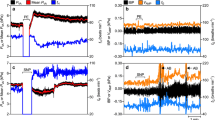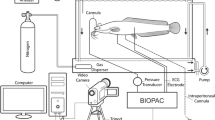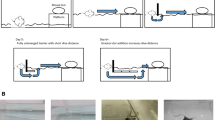Summary
Heart rate was chronically monitored (Figs. 1, 3) in two species of the marine gastropodAplysia. The warm waterA. brasiliana have an average basal heart rate in water of 33 min−1, whereas the cold waterA. californica's heart rate is 20.6 min−1. The heart rate in both species shows a strong temperature dependence and the difference in basal heart rate is negligible when measured at the same temperature (Fig. 2). Both species show a consistent bradycardia when exposed to air (Fig. 4):A. brasiliana showed a 43% average decrease in air, whereasA. californica showed only a 16.5% decrease. Removal of the abdominal ganglion produced no significant decrease in heart rate in either species, nor did it reduce the bradycardial response to air exposure inA. californica (Fig. 8). However, it significantly reduced, but did not abolish, the bradycardia inA. brasiliana (Figs. 5, 6, 7). We conclude that the bradycardia has a significant central component inA. brasiliana, but is peripherally mediated inA. californica. The bradycardial response to air exposure may be analogous to the diving response in air breathing vertebrates.
Similar content being viewed by others
References
Andersen, H.T.: Physiological adaptations in diving vertebrates. Physiol. Rev.46, 212–243 (1966)
Aspey, W.A., Blankenship, J.E.:Aplysia behavioral biology: I. A multivariate analysis of burrowing inA. brasiliana. J. Behav. Biol.17, 279–299 (1976a)
Aspey, W.A., Blankenship, J.E.: Aplysia behavioral biology: II. Induced burrowing in swimmingA. brasiliana by burrowed conspecifies. J. Behav. Biol.17, 301–312 (1976b)
Blankenship, J.E., Coggeshall, R.E.: The abdominal ganglion ofAplysia brasiliana: A comparative morphological and electrophysiological study, with notes onA. dactylomela. J. Neurobiol.7, 383–405 (1976)
Carew, T.J., Kandel, E.R.: Two functional effects of decreased conductance EPSP's: synaptic augmentation and increased electrotonic coupling. Science192, 150–153 (1976)
Carew, T.J., Pinsker, H., Rubinson, K., Kandel, E.R.: Physiological and biochemical properties of neuromuscular transmission between identified motor neurons and gill muscle inAplysia. J. Neurophysiol.27, 1020–1040 (1974)
Castellucci, V., Pinsker, H., Kupfermann, I., Kandel, E.R.: Neuronal mechanisms of habituation and dishabituation of the gill-withdrawal reflex inAplysia. Science167, 1745–1748 (1970)
Dieringer, N., Koester, J., Weiss, K.: Adaptive changes in heart rate ofAplysia californica. J. comp. Physiol., in press (1978)
Eales, N.B.:Aplysia. Proc. Trans. Liverpool, Biol. Soc. Mem.35, 183–266 (1921)
Eales, N.B.: Revision of the world species ofAplysia (Gastropoda Opisthobranchii). Bull. Brit. Mus. (Natural History) Zoo.5, 268–404 (1960)
Feinstein, R., Aspey, W., Schmale, M.: A miniaturized photocell assembly for monitoring heart rate in freely behavingAplysia (Mollusca: Gastropoda). J. Behav. Biol.17, 271–278 (1976)
Garey, W.F.: Cardiac responses of fishes in asphyxic environments. Biol. Bull. Marine, Biol. Lab. Woods Hole122, 362 (1962)
Hamilton, P.V., Ambrose, H.W., III: Swimming and orientation inAplysia brasiliana (Mollusca: Gastropoda). Marine Behav. Biol.3, 131–144 (1975)
Hill, R.B., Welsh, J.H.: Heart, circulation and blood cells. In: Physiology of Mollusca, Vol. 2 (eds. K.M. Wilbur, C.M. Yonge), pp. 126–174. New York, London: Academic Press 1966
Kandel, E.R., Kupfermann, I.: The functional organization of invertebrate ganglia. Ann. Rev. Physiol.32, 193–258 (1970)
Koester, J., Mayeri, E., Liebeswar, G., Kandel, E.R.: Cellular regulation of homeostasis: neural control of circulation inAplysia. Fed. Proc.32, 2179–2187 (1973)
Koester, J., Mayeri, E., Liebeswar, G., Kandel, E.R.: Neural control of circulation inAplysia. II. Interneurons. J. Neurophysiol.37, 476–496 (1974)
Krijgsman, B.J., Divaris, G.A.: Contractile and pacemaker mechanisms of the heart of molluscs. Biol. Rev.30, 1–39 (1955)
Kupfermann, I.: Stimulation of egg laying by extracts of neuroendocrine cells (bag cells) of abdominal ganglion ofAplysia. J. Neurophysiol.33, 877–881 (1970)
Kupfermann, I., Carew, T.: Behavior patters ofAplysia californica in its natural habitat. Behav. Biol.12, 317–337 (1974)
Kupfermann, I., Kandel, E.R.: Neuronal controls of a behavioral response mediated by the abdominal ganglion ofAplysia. Science164, 847–850 (1969)
Lee, R.M.:Aplysia Behavior: Effects of contingent water-level variation. Comm. Behav. Biol.4, 157–164 (1969)
Leivestad, H., Andersen, H.T., Scholander, P.F.: Physiological response to air exposure in codfish. Science126, 505 (1957)
Liebeswar, G., Goldman, J.E., Loester, J., Mayeri, E.: Neural control of circulation inAplysia. III. Neurotransmitters. J. Neurophysiol.38, 767–779 (1975)
Mayeri, E., Koester, J., Liebeswar, G.: Functional organization of neural control of circulation inAplysia. Amer. Zool.14, 943–956 (1974a)
Mayeri, E., Koester, J., Kupfermann, I., Liebeswar, G., Kandel, E.R.: Neural control of circulation inAplysia. I. Motor neurons. J. Neurophysiol.37, 458–475 (1974b)
Pinsker, H.P., Dudek, F.E.: Spontaneous bag cell activity and egg laying in freely-behavingAplysia. Science197, 490–493 (1977)
Pinsker, H., Feinstein, R., Gooden, B.A.: Bradycardia response inAplysia exposed to air. Fed. Proc.33, 361 (1974)
Pinsker, H., Kupfermann, I., Castellucci, V., Kandel, E.R.: Habituation and dishabituation of the gill-withdrawal reflex inAplysia. Science167, 1740–1742 (1970)
Siegel, S.: Nonparametric statistics for the behavioral sciences. New York: McGraw-Hill 1956
Tauc, L.: Transmission in invertebrate and vertebrate ganglia. Physiol. Rev.47, 521–593 (1967)
Author information
Authors and Affiliations
Rights and permissions
About this article
Cite this article
Feinstein, R., Pinsker, H., Schmale, M. et al. Bradycardial response inAplysia exposed to air. J Comp Physiol B 122, 311–324 (1977). https://doi.org/10.1007/BF00692518
Received:
Issue Date:
DOI: https://doi.org/10.1007/BF00692518




